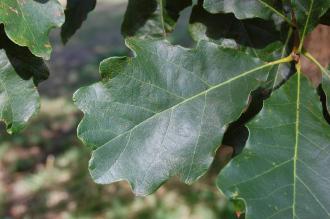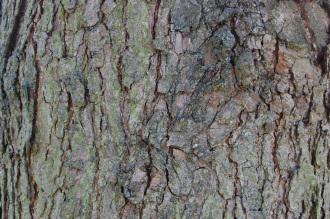
Quercus bicolor (15/08/15, Kew Gardens, London)
Position: Full sun
Flowering period: Late winter to early spring
Soil: Moist, well drained
Eventual Height: 20m
Eventual Spread: 20m
Hardiness: 4a, 4b, 5a, 5b, 6a, 6b, 7a, 7b, 8a, 8b
Family: Fagaceae
Quercus bicolor is a deciduous tree with a rounded to broadly spreading habit. Its shiny, dark green leaves are obovate and deeply lobed, up to 20cm long and 10cm broad. Its leaves turn red/ bronze/ yellow in autumn before they fall. Its grey/ brown bark is deeply fissured, forming small plates. Its trunk may achieve a diameter of up to 1.5m. Its green/ brown flowers are monoecious, the male appearing as catkins and the female appearing solitary. Its green fruit is an ellipsoid acorn which is up to 25mm long, these mature to a pale brown. Its roots are fibrous as well as having a tap root.

Quercus bicolor Leaf (15/08/15, Kew Gardens, London)
Quercus bicolor, commonly known as the Swamp White Oak, is native to central and western North America. In its native habitat it grows in lowlands, stream margins, swamps and mixed woodland. Quercus bicolor was first described by Carl Ludwig Von Willdenow in 1801.
The etymological root of the binomial name Quercus is derived from the Latin name for an Oak tree, but some authorities believe it to be derived from the Celtic quer meaning ‘fine’ and cuez meaning ‘a tree’. Bicolor is from the Latin meaning ‘of two colours’
The landscape architect may find Quercus bicolor useful as a specimen tree with attractive autumn leaf color. This species is highly tolerant of damp conditions and extended periodic flooding once established.

Quercus bicolor Bark (15/08/15, Kew Gardens, London)
Ecologically, Quercus bicolor acorns are attractive to some birds and mammals.
Quercus bicolor prefers moist, fertile, well-drained soils. It will tolerate most pH of soil. It will tolerate wet soils.
Quercus bicolor requires little maintenance.

Landscape Architecture

